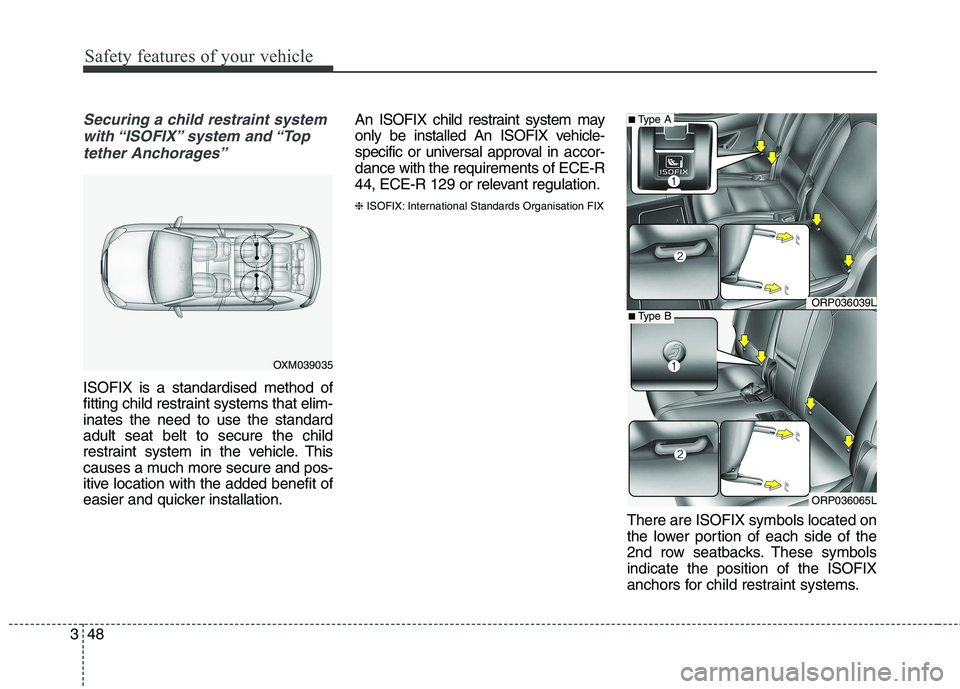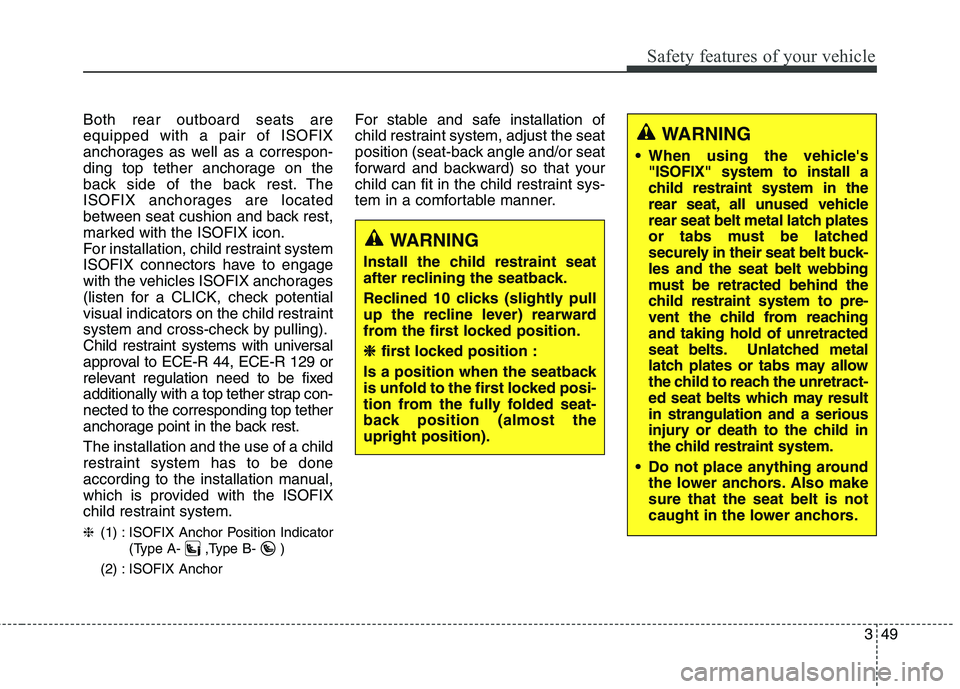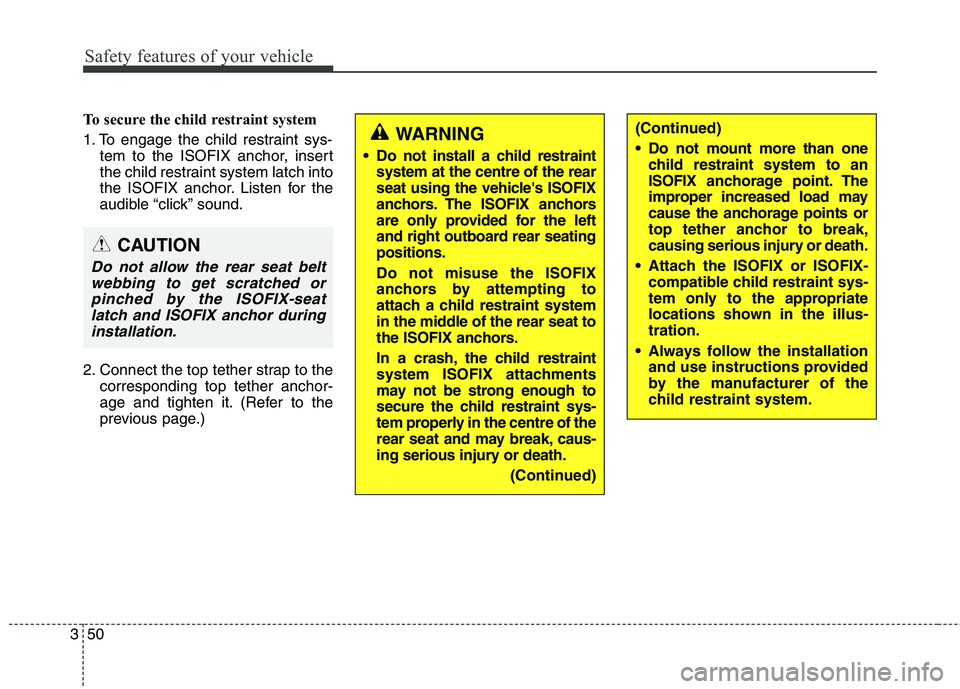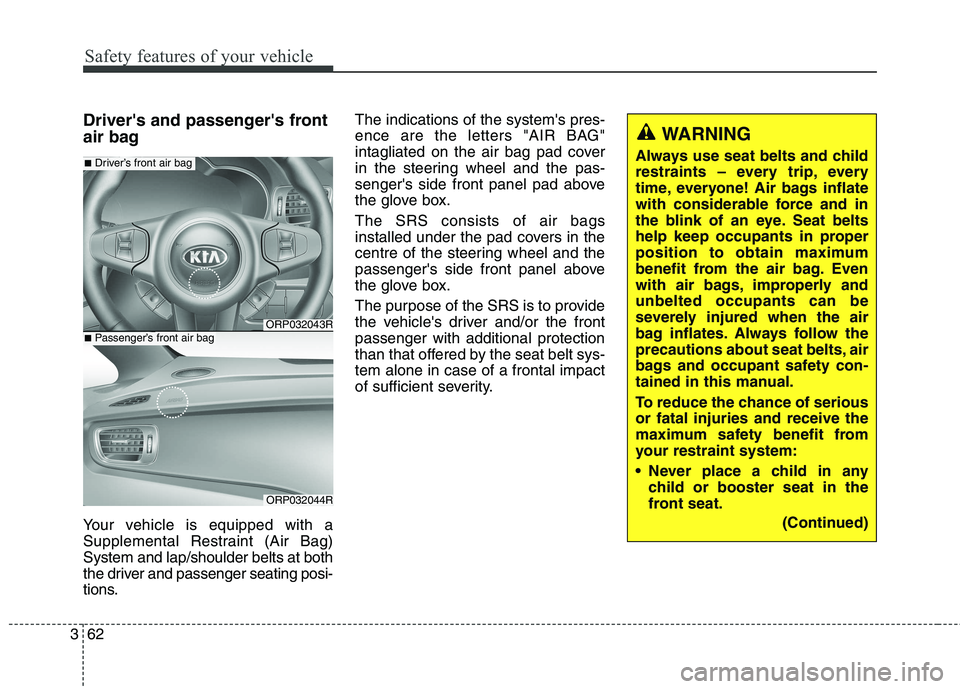2017 KIA CARENS RHD belt
[x] Cancel search: beltPage 66 of 723

Safety features of your vehicle
48
3
Securing a child restraint system
with “ISOFIX” system and “Top tether Anchorages”
ISOFIX is a standardised method of
fitting child restraint systems that elim-inates the need to use the standardadult seat belt to secure the child
restraint system in the vehicle. This
causes a much more secure and pos-
itive location with the added benefit of
easier and quicker installation. An ISOFIX child restraint system may
only be installed An ISOFIX vehicle-
specific or universal approval in
accor-
dance with the requirements of ECE-R
44, ECE-R 129 or relevant regulation. ❈ ISOFIX: International Standards Organisation FIX
There are ISOFIX symbols located on
the lower portion of each side of the
2nd row seatbacks. These symbolsindicate the position of the ISOFIX
anchors for child restraint systems.
ORP036039L
ORP036065L
■Type A
■Type B
OXM039035
Page 67 of 723

349
Safety features of your vehicle
Both rear outboard seats are equipped with a pair of ISOFIX
anchorages as well as a correspon-
ding top tether anchorage on the
back side of the back rest. The
ISOFIX anchorages are located
between seat cushion and back rest,
marked with the ISOFIX icon.
For installation, child restraint system
ISOFIX connectors have to engage
with the vehicles ISOFIX anchorages
(listen for a CLICK, check potential
visual indicators on the child restraint
system and cross-check by pulling).
Child restraint systems with universal
approval to ECE-R 44, ECE-R 129 or
relevant regulation need to be fixed
additionally with a top tether strap con-nected to the corresponding top tether
anchorage point in the back rest. The installation and the use of a child
restraint system has to be done
according to the installation manual,
which is provided with the ISOFIX
child restraint system. ❈(1) : ISOFIX Anchor Position Indicator
(Type A- ,Type B- )
(2) : ISOFIX Anchor For stable and safe installation of
child restraint system, adjust the seat
position (seat-back angle and/or seat
forward and backward) so that your
child can fit in the child restraint sys-
tem in a comfortable manner.
WARNING
Install the child restraint seat
after reclining the seatback.
Reclined 10 clicks (slightly pull
up the recline lever) rearward
from the first locked position. ❈
❈ first locked position :
Is a position when the seatback
is unfold to the first locked posi-
tion from the fully folded seat-
back position (almost theupright position).
WARNING
When using the vehicle's "ISOFIX" system to install a
child restraint system in the
rear seat, all unused vehicle
rear seat belt metal latch plates
or tabs must be latched
securely in their seat belt buck-les and the seat belt webbing
must be retracted behind the
child restraint system to pre-
vent the child from reachingand taking hold of unretracted
seat belts. Unlatched metal
latch plates or tabs may allow
the child to reach the unretract-
ed seat belts which may resultin strangulation and a serious
injury or death to the child in
the child restraint system.
Do not place anything around the lower anchors. Also makesure that the seat belt is not
caught in the lower anchors.
Page 68 of 723

Safety features of your vehicle
50
3
To secure the child restraint system
1. To engage the child restraint sys-
tem to the ISOFIX anchor, insert
the child restraint system latch into
the ISOFIX anchor. Listen for the
audible “click” sound.
2. Connect the top tether strap to the corresponding top tether anchor-
age and tighten it. (Refer to the
previous page.)
CAUTION
Do not allow the rear seat belt
webbing to get scratched orpinched by the ISOFIX-seat latch and ISOFIX anchor duringinstallation.
WARNING
Do not install a child restraint system at the centre of the rear
seat using the vehicle's ISOFIX
anchors. The ISOFIX anchors
are only provided for the left
and right outboard rear seatingpositions. Do not misuse the ISOFIX
anchors by attempting to
attach a child restraint system
in the middle of the rear seat to
the ISOFIX anchors.
In a crash, the child restraint
system ISOFIX attachments
may not be strong enough to
secure the child restraint sys-
tem properly in the centre of the
rear seat and may break, caus-
ing serious injury or death.
(Continued)(Continued)
Do not mount more than onechild restraint system to an
ISOFIX anc horage point. The
improper increased load may
cause the anchorage points or
top tether anchor to break,
causing serious injury or death.
Attach the ISOFIX or ISOFIX- compatible child restraint sys-
tem only to the appropriate
locations shown in the illus-tration.
Always follow the installation and use instructions provided
by the manufacturer of the
child restraint system.
Page 72 of 723

Safety features of your vehicle
54
3
How does the air bag system operate
Air bags are activated (able to
inflate if necessary) only when the
ignition switch is turned to the ON
or START position.
Air bags inflate instantly in the event of serious frontal or side col-lision (if equipped with side air bag
or curtain air bag) in order to help
protect the occupants from serious
physical injury.
There is no single speed at which the air bags will inflate.
Generally, air bags are designed to
inflate based upon the severity of a
collision and its direction. These
two factors determine whether thesensors produce an electronic
deployment/ inflation signal.
Air bag deployment depends on a number of factors including vehiclespeed, angles of impact and the
density and stiffness of the vehi-
cles or objects which your vehicle
hits in the collision. The determin-
ing, factors are not limited to those
mentioned above. The front air bags will completely
inflate and deflate in an instant.
It is virtually impossible for you to
see the air bags inflate during an
accident. It is much more likely that
you will simply see the deflated air
bags hanging out of their storage
compartments after the collision.
In order to help provide protection in a severe collision, the air bags
must inflate rapidly. The speed ofair bag inflation is a consequence
of extremely short time in which acollision occurs and the need to
get the air bag between the occu-
pant and the vehicle structures
before the occupant impacts those
structures. This speed of inflation
reduces the risk of serious or life-
threatening injuries in a severe col-
lision and is thus a necessary partof air bag design.
However, air bag inflation can also
cause injuries which can include
facial abrasions, bruises and bro-
ken bones because the inflationspeed also causes the air bags to
expand with a great deal of force.WARNING
Even in vehicles with air bags, you and your passengers must
always wear the safety belts
provided in order to minimise
the risk and severity of injury
in the event of a collision or in
most rollover situation.
SRS and pretensioners con- tain explosive chemicals.
If scraping a vehicle without
removing SRS and pretension-
ers from a vehicle, it may cause
fire. Before scraping a vehicle,
we recommend that you con-
tact an authorised Kia dealer.
Keep the SRS parts and wirings away from water or any
liquid. If the SRS components
are inoperative due to expo-
sure to water or liquids, it may
cause fire or severe injury.
Page 73 of 723

355
Safety features of your vehicle
There are even circumstancesunder which contact with the
steering wheel air bag can cause
fatal injuries, especially if the
occupant is positioned exces-
sively close to the steering wheel.Noise and smoke
When the air bags inflate, they make
a loud noise and they leave smoke
and powder in the air inside of the
vehicle. This is normal and is a result
of the ignition of the air bag inflator.
After the air bag inflates, you may
feel substantial discomfort in breath-
ing due to the contact of your chestwith both the seat belt and the air
bag, as well as from breathing the
smoke and powder. Open your
doors and/or windows as soon as
possible after impact in order to
reduce discomfort and prevent
prolonged exposure to the smoke
and powder.
Though smoke and powder are non-
toxic, it may cause irritation to the
skin (eyes, nose and throat, etc.). If
this is the case, wash and rinse with
cold water immediately and consult
the doctor if the symptom persists.
WARNING
To avoid severe personal injury or death caused by
deploying air bags in a colli-
sion, the driver should sit as
far back from the ste ering
wheel air bag. The front pas-
senger should always move
their seat as far back as pos-
sible and sit back in their seat.
Air bag inflates instantly in an event of a collision, passen-
gers may be injured by the air
bag expansion force if they
are not in a proper position.
Air bag inflation may cause injuries including facial or
bodily abrasions, injuries from
broken glasses or burns.
WARNING
When the air bags deploy, the
air bag related parts in thesteering wheel and/or instru-ment panel and/or in both sides
of the roof rails above the front
and rear doors are very hot. To
prevent injury, do not touch the
air bag storage areas internal
components immediately after
an air bag has inflated.
Page 77 of 723

359
Safety features of your vehicle
SRS components and functions
The SRS consists of the following components:
1. Driver's front air bag module
2. Passenger's front air bag module
3. Side air bag modules*
4. Curtain air bag modules*
5. Retractor pre-tensioner assemblies
6. Air bag warning light
7. SRS control module (SRSCM)
8. Front impact sensors
9. Side impact sensors*10. Passenger’s front air bag
ON/OFF indicator*
11. Passenger’s front air bag ON/OFF switch*
12. EFD (Emergency Fastening Device)*
* : if equipped
The SRSCM continually monitors all
elements whilst the ignition switch is
ON to determine if a frontal, near-frontal impact or side impact is
severe enough to require air bag
deployment or pre-tensioner seat belt
deployment.
The SRS air bag warning light on the
instrument panel will illuminate forabout 6 seconds after the ignition
switch is turned to the ON position,
after which the air bag warning lightshould go out.
ORP036093R
WARNING
If any of the following condi-
tions occurs, this indicates a
malfunction of the SRS. We rec-ommend that the system be
inspected by an authorised Kia
dealer.
The light does not turn on briefly when you turn the igni- tion ON.
The light stays on after illumi- nating for approximately 6seconds.
The light comes on whilst the vehicle is in motion.
The light blinks when the igni- tion switch is in ON position.
Page 78 of 723

Safety features of your vehicle
60
3
The air bag modules are located
both in the centre of the steeringwheel and in the front passenger's
panel above the glove box. When the
SRSCM detects a sufficiently severe
impact to the front of the vehicle, it
will automatically deploy the front air
bags. Upon deployment, tear seams mold-
ed directly into the pad covers will
separate under pressure from the
expansion of the air bags. Further
opening of the covers then allows full
inflation of the air bags.
A fully inflated air bag, in combina-
tion with a properly worn seat belt,
slows the driver's or the passenger's
forward motion, reducing the risk of
head and chest injury. After complete inflation, the air bag
immediately starts deflating, enabling
the driver to maintain forward visibili-
ty and the ability to steer or operate
other controls.
OQL036106R
Driver’s front air bag (1)
OQL036107R
Driver’s front air bag (2)
OQL036108R
Driver’s front air bag (3)
Page 80 of 723

Safety features of your vehicle
62
3
Driver's and passenger's front
air bag
Your vehicle is equipped with a
Supplemental Restraint (Air Bag)System and lap/shoulder belts at both
the driver and passenger seating posi-
tions. The indications of the system's pres-
ence are the letters "AIR BAG"
intagliated on the air bag pad cover
in the steering wheel and the pas-
senger's side front panel pad above
the glove box. The SRS consists of air bags
installed under the pad covers in the
centre of the steering wheel and the
passenger's side front panel above
the glove box.
The purpose of the SRS is to provide
the vehicle's driver and/or the frontpassenger with additional protection
than that offered by the seat belt sys-tem alone in case of a frontal impact
of sufficient severity.
ORP032043R
■
Driver’s front air bag
ORP032044R
■Passenger’s front air bag
WARNING
Always use seat belts and child
restraints – every trip, every
time, everyone! Air bags inflate
with considerable force and in
the blink of an eye. Seat belts
help keep occupants in proper
position to obtain maximum
benefit from the air bag. Even
with air bags, improperly andunbelted occupants can be
severely injured when the air
bag inflates. Always follow the
precautions about seat belts, air
bags and occupant safety con-
tained in this manual.
To reduce the chance of serious or fatal injuries and receive the
maximum safety benefit from
your restraint system:
Never place a child in any child or booster seat in the
front seat.
(Continued)